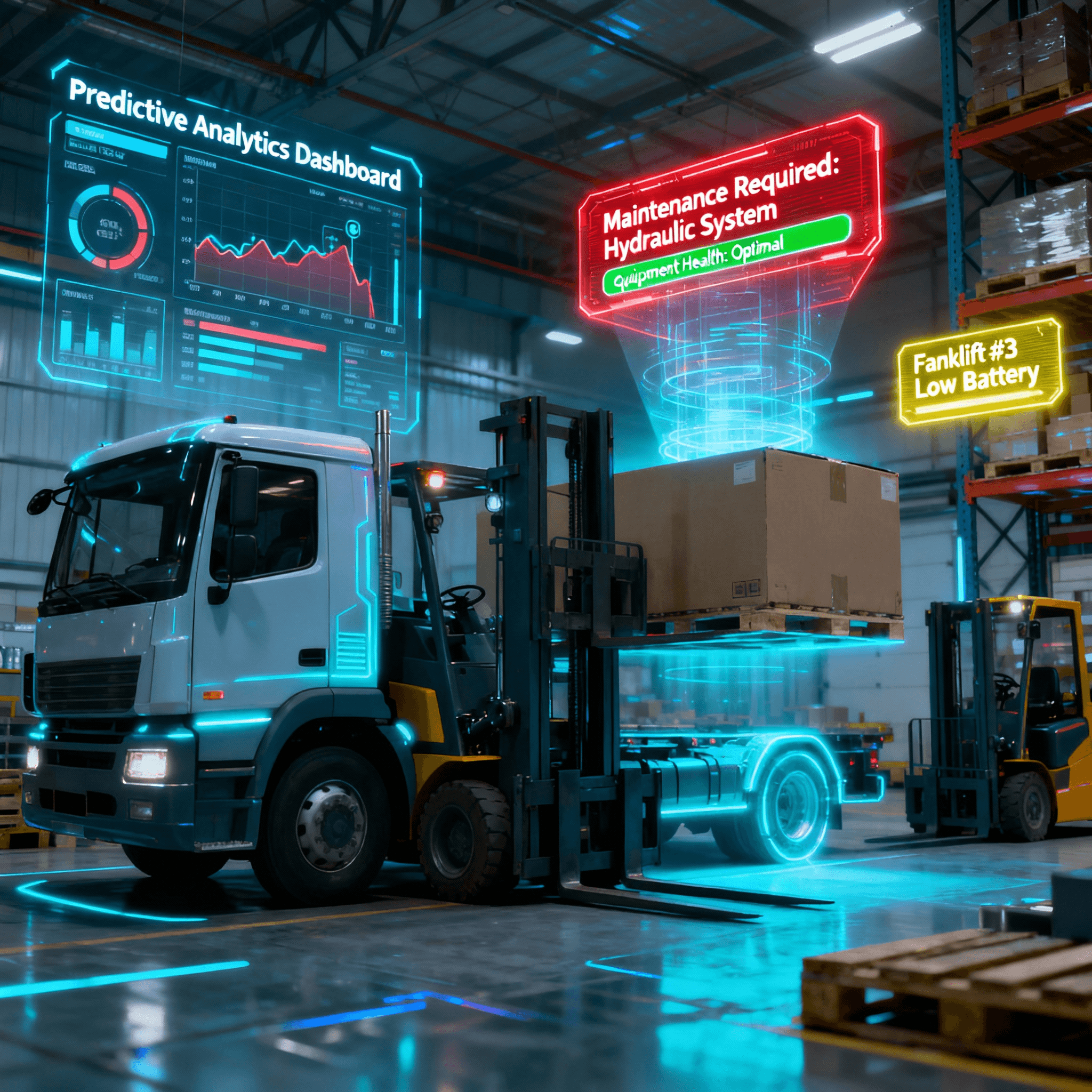Can AI Predict When Delivery Trucks and Warehouse Machines Need Maintenance?
Tuesday, 30 Sep 2025
|
Can AI Predict When a Delivery Truck or Warehouse Machine Needs Maintenance?
Equipment failure doesn't announce itself—until it's too late. A delivery truck breaks down mid-route, stranding a driver and delaying dozens of time-sensitive shipments. A critical warehouse conveyor system suddenly stops, halting order fulfillment and creating a cascade of missed delivery commitments. The costs are staggering: emergency repairs, lost productivity, customer penalties, and reputational damage.
Traditional maintenance approaches fall into two extremes: reactive (fixing things after they break) or preventive (servicing on fixed schedules regardless of actual condition). Both waste money—reactive maintenance through emergency repairs and downtime, preventive through unnecessary servicing of healthy equipment.
AI-powered predictive maintenance represents a fundamental breakthrough. By analyzing real-time sensor data, historical performance patterns, and operational conditions, AI predicts equipment failures days or weeks before they occur—enabling proactive repairs during planned downtime rather than disruptive emergency responses.
Organizations implementing AI predictive maintenance report 30-50% reductions in equipment downtime, 20-40% lower maintenance costs, and 25-35% longer asset lifespans. For logistics operations where every hour of equipment availability directly impacts revenue, this isn't incremental improvement—it's transformational.
Wondering how AI knows when a truck engine or conveyor motor will fail before maintenance teams see any warning signs? The answer lies in patterns invisible to human observation but crystal clear to machine learning algorithms.
The Problem with Traditional Maintenance Approaches
Reactive Maintenance: Fixing After Failure
Waiting until equipment breaks creates multiple cascading problems:
Operational disruption: Unplanned downtime halts deliveries or warehouse operations
Emergency costs: Expedited parts and after-hours labor cost 3-4x more than planned maintenance
Secondary damage: Initial failures often cause additional component damage during breakdown
Safety risks: Equipment failures can endanger drivers and warehouse workers
Customer impact: Missed deliveries damage relationships and trigger penalty clauses
Preventive Maintenance: Fixed Schedules
Servicing equipment on time-based schedules (every X hours or Y miles) reduces unexpected failures but creates inefficiencies:
Over-maintenance: Replacing components that still have useful life wastes money
Under-maintenance: Fixed schedules may miss issues developing between service intervals
Inflexibility: Ignores actual equipment usage patterns and operating conditions
Resource waste: Unnecessary labor and parts consumption
For context on how AI differs from traditional approaches, explore What's the Difference Between AI, Machine Learning, and Automation in a Warehouse Context?.
How AI Predictive Maintenance Works
AI predictive maintenance transforms maintenance from guesswork into data-driven science through a four-stage process:
Stage 1: Continuous Data Collection
IoT sensors embedded in equipment capture real-time performance metrics:
For delivery trucks:
- Engine temperature, oil pressure, and RPM patterns
- Brake pad thickness and hydraulic pressure
- Tire pressure, temperature, and tread depth
- Transmission shifting patterns and fluid conditions
- Battery voltage and charging system performance
- Vibration analysis detecting bearing or alignment issues
For warehouse equipment:
- Conveyor belt tension, speed, and motor temperature
- Robotic arm cycle counts and joint wear indicators
- Forklift hydraulic system pressure and temperatures
- Automated storage system motor currents and vibrations
- Environmental conditions (temperature, humidity, dust)
Even without IoT sensors: Companies can begin with historical maintenance logs, ERP data, and equipment usage records to create baseline predictive models.
Stage 2: AI-Powered Data Analysis
Machine learning algorithms process millions of data points to identify patterns indicating impending failures:
Pattern recognition: AI detects subtle deviations from normal operating conditions—temperature increases, unusual vibrations, declining efficiency
Anomaly detection: Algorithms flag unusual patterns that fall outside expected performance ranges
Failure modeling: ML models trained on historical failure data recognize conditions preceding past breakdowns
Remaining Useful Life (RUL) estimation: AI predicts how long components will continue functioning before replacement needed
Learn more about the AI algorithms enabling these capabilities in Most Common AI Algorithms Used for Route Planning and Demand Forecasting.
Stage 3: Predictive Alerts and Recommendations
When AI detects potential failures, it generates prioritized maintenance recommendations:
Early warnings: Alerts typically provide 7-30 days advance notice before failures occur
Severity classification: AI ranks issues by urgency and operational impact
Specific diagnosis: Systems identify which component requires attention (e.g., "left rear brake pads at 15% remaining life")
Maintenance scheduling: Recommendations include optimal timing to minimize operational disruption
Stage 4: Continuous Learning and Optimization
AI systems improve prediction accuracy over time through continuous learning:
- Analyzing outcomes of maintenance actions to refine models
- Incorporating new failure patterns as they're discovered
- Adapting to equipment modifications and operating condition changes
- Personalizing predictions for individual assets based on their unique usage patterns
Understand how this continuous improvement connects to broader supply chain intelligence in How Predictive Analytics Works for Logistics.
Real-World Predictive Maintenance Success Stories
DHL: Warehouse Automation Reliability
DHL implemented AI predictive maintenance across warehouse conveyor systems globally:
Approach: IoT sensors monitoring vibration, temperature, and performance patterns on conveyor belts, sortation systems, and automated storage equipment
AI analysis: Machine learning models identifying wear-and-tear trends before failures occur
Results:
- Reduced unexpected conveyor breakdowns by 45%
- 25% decrease in overall maintenance costs
- Improved order fulfillment consistency during peak seasons
Maersk: Maritime Logistics Fleet Management
Maersk deployed AI-driven predictive maintenance across its vessel fleet:
Implementation: Comprehensive sensor networks monitoring engines, navigation systems, and propulsion equipment
Predictive capabilities: AI forecasting component failures weeks in advance
Business impact:
- 30% reduction in vessel downtime
- Over $300 million in annual savings
- Improved schedule reliability for customers
Intangles (Fleet Operators): Truck Predictive Maintenance
Commercial fleets using Intangles' AI predictive maintenance platform report transformational improvements:
Technology: Real-time truck health monitoring analyzing engine performance, brake conditions, and component wear
Predictive accuracy: AI identifying potential failures 2-4 weeks before occurrence
Measurable outcomes:
- Up to $2,500 savings per truck annually
- 50% reduction in unexpected breakdowns
- Significant improvement in fleet uptime and reliability
Explore how predictive capabilities integrate with fleet optimization in Real-World Examples of AI Route Optimization.
Bosch: Industrial Equipment Maintenance
Bosch applies AI predictive maintenance to warehouse industrial robots and automated equipment:
Monitoring: Continuous analysis of robot performance, cycle counts, and stress indicators
Proactive servicing: Maintenance scheduled based on actual equipment condition rather than fixed intervals
Results:
- Improved equipment reliability and uptime
- Minimized costly production disruptions
- Extended robot operational lifespans
Quantified Business Benefits
Organizations implementing comprehensive AI predictive maintenance report consistent, significant improvements:
Cost Reduction
- 20-40% lower maintenance costs through optimized servicing and parts usage
- 30-50% reduction in emergency repair expenses by avoiding breakdowns
- 25-35% decrease in spare parts inventory through precise forecasting
- 15-25% fuel savings from optimally maintained vehicle fleets
Operational Efficiency
- 30-50% reduction in equipment downtime
- 25-35% longer asset lifespans through proactive care
- 40-60% decrease in safety incidents related to equipment failure
- Improved delivery reliability through reduced truck breakdowns
Strategic Advantages
- Enhanced customer satisfaction through reliable delivery performance
- Better resource allocation focusing maintenance teams on true needs
- Data-driven capital planning for equipment replacement timing
- Competitive edge through superior operational reliability
For insights into how these improvements impact inventory and warehouse operations, read In What Ways Does AI Automate and Improve Inventory Management?.
Technologies Powering Predictive Maintenance
IoT Sensors and Edge Computing
Modern predictive maintenance relies on comprehensive sensor networks:
Sensor types:
- Temperature sensors monitoring heat generation
- Vibration sensors detecting abnormal movement patterns
- Pressure sensors tracking hydraulic and pneumatic systems
- Acoustic sensors using sound analysis for fault detection
- Current sensors measuring electrical load patterns
Edge computing: Local processing enabling real-time analysis and immediate alerts even without constant cloud connectivity.
Machine Learning Models
Various ML algorithms excel at different predictive maintenance challenges:
Regression models: Predicting remaining useful life of components
Classification algorithms: Categorizing equipment health status
Anomaly detection: Identifying unusual patterns indicating problems
Neural networks: Capturing complex relationships in multi-variable equipment data
Ensemble methods: Combining multiple models for superior prediction accuracy
Cloud Platforms and AI Integration
Centralized cloud platforms aggregate data from distributed assets, enabling fleet-wide insights and continuous model improvement.
Learn about visual inspection capabilities in How Computer Vision Technology Helps in Logistics Operations.
Implementation Best Practices
Successful AI predictive maintenance deployments follow structured approaches:
Phase 1: Pilot with Critical Assets
Start focused: Identify high-impact equipment where failures cause maximum disruption (e.g., primary delivery vehicles, critical conveyor systems)
Prove ROI: Demonstrate measurable benefits before expanding deployment
Build expertise: Develop internal knowledge managing AI-powered maintenance systems
Phase 2: Integrate Data Sources
Merge diverse inputs: Combine sensor data, maintenance logs, usage records, and ERP/WMS data for holistic visibility
Ensure data quality: Clean, normalize, and validate data feeding AI models
Establish baselines: Define normal operating parameters for each equipment type
For data requirements guidance, visit What Kind of Data is Needed to Train an Effective AI Model for Supply Chain Optimization?.
Phase 3: Cross-Functional Collaboration
Unite departments: Maintenance, IT, operations, and fleet management must work together
Upskill teams: Train staff to understand AI-generated insights and integrate them into workflows
Define processes: Establish clear protocols for responding to predictive alerts
Phase 4: Measure and Refine
Track KPIs: Monitor mean time between failures (MTBF), maintenance cost reductions, and downtime improvements
Continuous refinement: Regularly evaluate and improve model accuracy
Expand strategically: Scale successful implementations to additional equipment classes
How debales.ai Enables Predictive Maintenance Intelligence
At debales.ai, our AI platform integrates predictive maintenance capabilities designed for logistics operations:
Fleet Health Monitoring: Real-time analysis of delivery vehicle conditions with failure predictions and maintenance recommendations
Warehouse Equipment Intelligence: Continuous monitoring of conveyors, robotics, and material handling systems
Unified Visibility: Single dashboard showing equipment health across entire logistics networks
Automated Alerting: Proactive notifications when maintenance interventions are recommended
Integration Ready: Seamless connection with existing maintenance management, fleet telematics, and ERP systems
Explainable AI: Transparent reasoning showing why maintenance is recommended and what data drives predictions
Our approach combines predictive intelligence with the broader orchestration capabilities described in What is an AI-Powered Control Tower in Logistics?.
The Future: Autonomous Maintenance Management
Next-generation systems are evolving toward autonomous maintenance management—AI not only predicting failures but automatically scheduling repairs, ordering parts, and optimizing maintenance team workflows without human intervention.
This autonomous capability aligns with the digital twin vision explored in What is a Digital Twin and How is it Used in Logistics AI?.
Strategic Imperative: From Reactive to Predictive
Equipment downtime costs logistics operations thousands per hour in lost productivity, missed deliveries, and emergency repairs. AI predictive maintenance transforms this liability into manageable, planned maintenance that minimizes disruption and maximizes asset longevity.
Organizations still relying on reactive or time-based preventive approaches face widening efficiency gaps against AI-enabled competitors achieving 30-50% better equipment uptime and 20-40% lower maintenance costs.
Ready to transform maintenance from expensive disruption into predictable, optimized operations?
Discover how debales.ai's AI-powered platform delivers predictive maintenance intelligence that prevents failures, reduces costs, and maximizes equipment availability across fleets and warehouses.
Book a demo with debales.ai today and experience how AI turns equipment health monitoring into strategic competitive advantage.
All blog posts
View All →
Friday, 28 Nov 2025
The 90-Day Roadmap: Moving from Ad-Hoc AI to Operational Excellence
Stuck in AI experimentation? Learn how to escape Level 2 maturity using the Mess-O-Meter to diagnose chaos, prioritize with triangulation, and scale in 90 days.

Thursday, 27 Nov 2025
Mess-O-Meter Deep Dive: Real Logistics Examples for Digital Maturity
Discover Mess-O-Meter examples diagnosing digital chaos in logistics—baseline workflows, benchmark maturity, create AI roadmaps with real steps for transformation success.

Wednesday, 26 Nov 2025
Multi-Agent AI via Email: End-to-End Automation for Logistics Complexity
Explore agentic orchestration where autonomous email AI agents coordinate freight, customs, insurance, and carriers—automating multi-party processes for resilient supply chains.